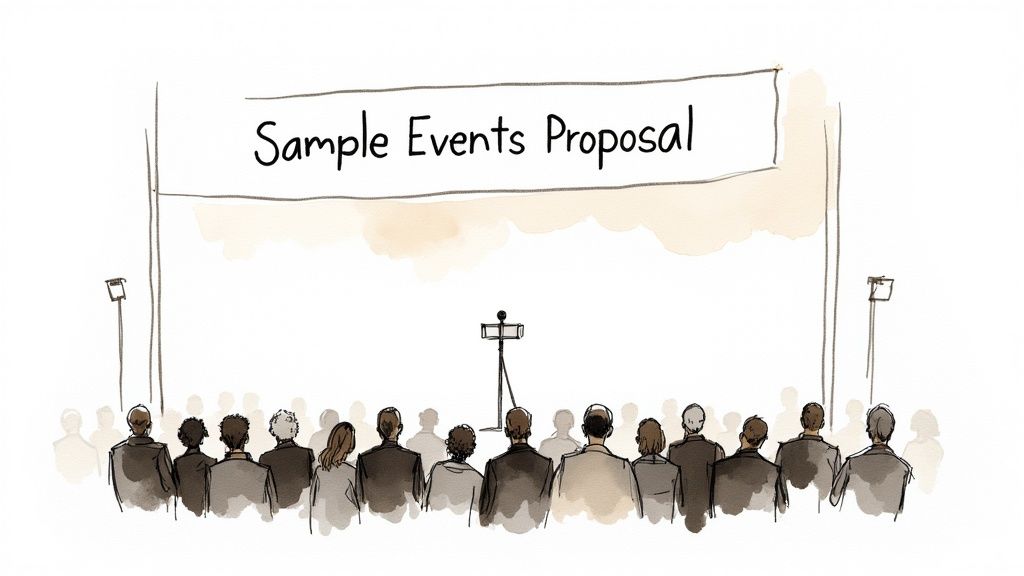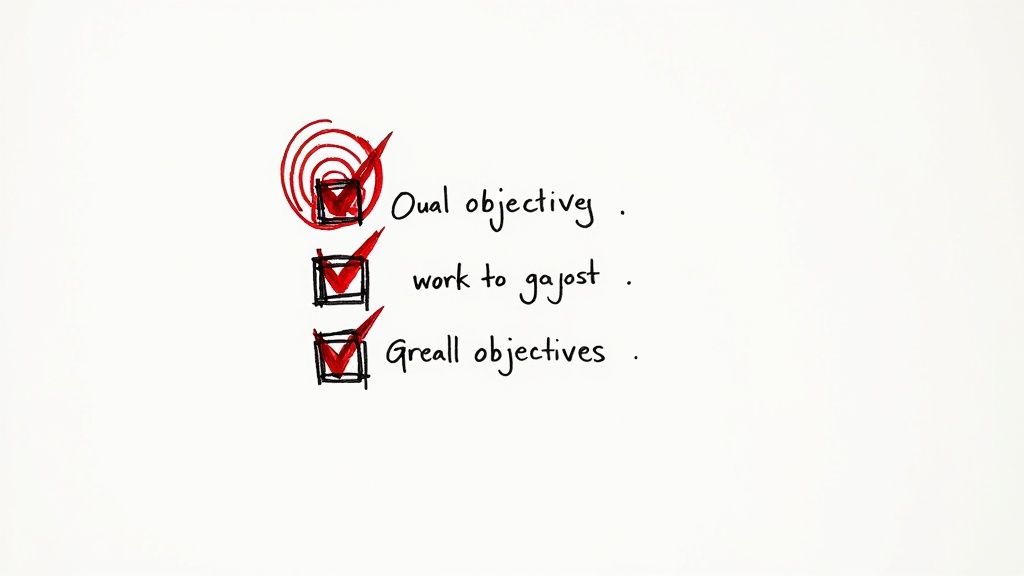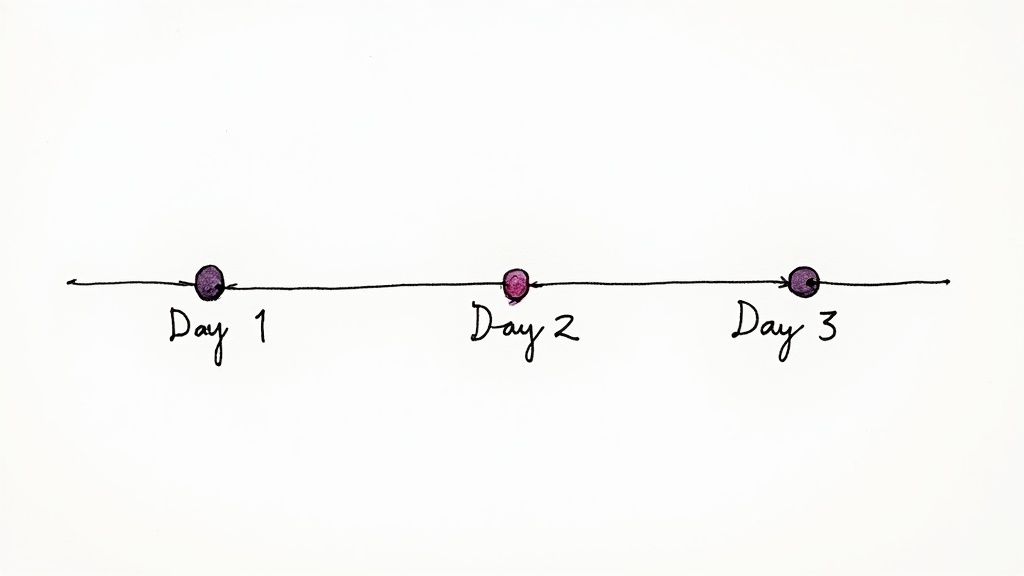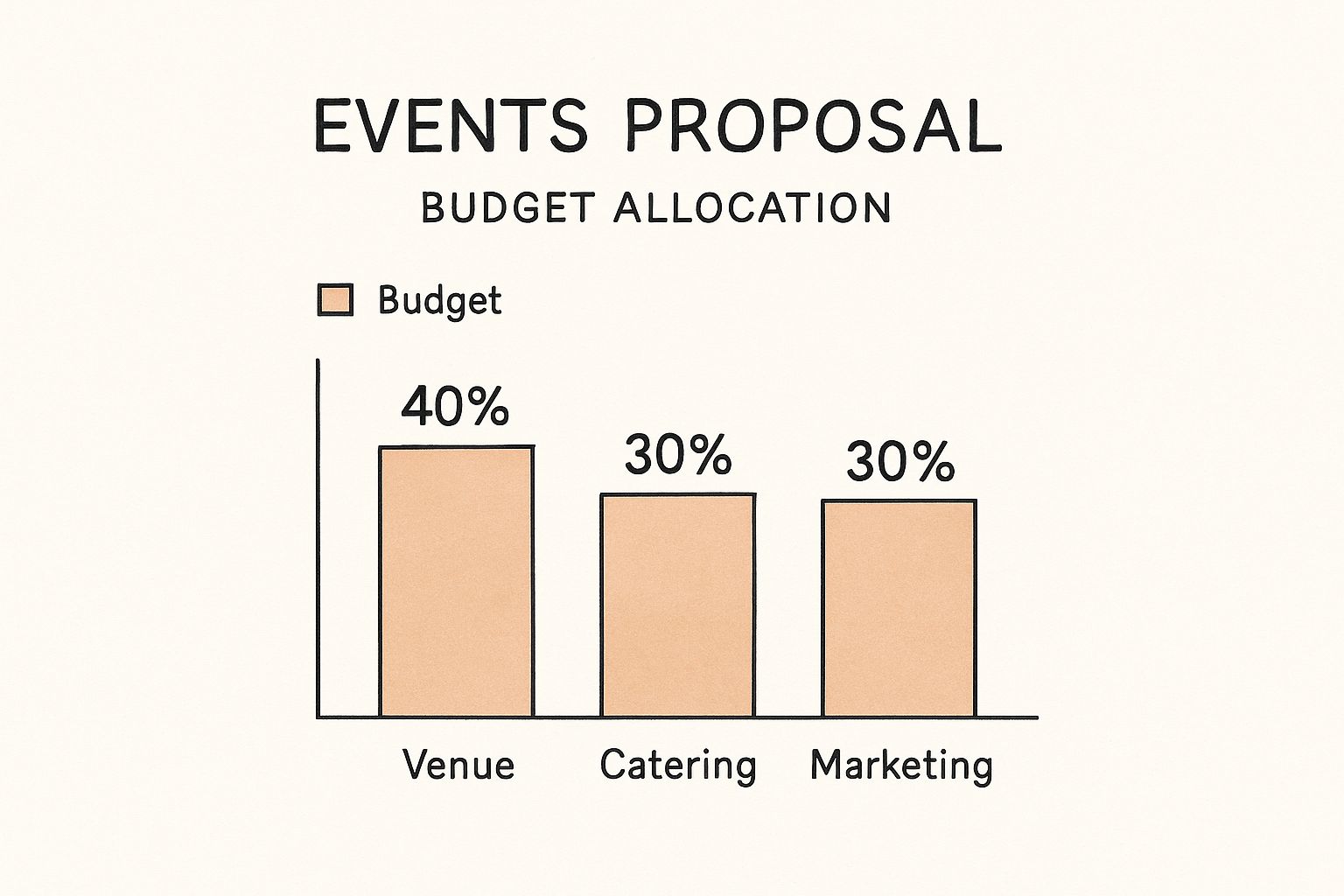August 24, 2025

A great event proposal does so much more than just list out your services. It tells a story—one that weaves your creative vision directly into your client's most important goals. Think of it as a strategic document, meticulously crafted to build trust, showcase your expertise, and make saying "yes" feel like the most natural decision in the world.

Before we get into specific templates, let's talk about the psychology of a proposal that actually wins business. This isn't just a sales pitch; it's the start of a partnership. Your number one goal is to prove you don't just hear the client's problem—you truly understand it, and you have the perfect solution ready to go.
This means every single part of your proposal, from the opening line to the final budget number, needs to be laser-focused on their desired outcomes. Are they trying to generate qualified leads? Boost brand visibility? Or maybe improve internal team morale? A persuasive proposal shows, right from the jump, that you've done your homework.
I've seen countless proposals fall flat because they were all about the planner, not the client. The most effective ones are always client-centric. Instead of leading with what you do, you need to start with why it matters to them.
Position your event concept as the direct answer to their biggest business challenges. When you do this, your proposal transforms from a simple menu of services into a strategic blueprint for their success.
To pull this off, your document has to clearly answer a few key questions:
This strategic framing isn't just a nice-to-have; it's essential. The global events industry is absolutely booming, with a market size estimated at USD 1,406 billion and still climbing. This explosive growth proves just how much companies are investing in experiential engagement, making a results-driven proposal more critical than ever.
Every proposal that gets a signature has a few foundational elements in common. These are the pillars that support your creative vision and prove your logistical chops. At a bare minimum, you need a clear structure that walks the client through the event vision, the detailed services you'll provide, a transparent budget, and a clear call to action.
To give you a quick reference, here are the absolute essentials every winning proposal needs.
Think of these components as your roadmap to getting that "yes."
A great proposal doesn't just sell an event; it sells confidence. It assures the client that every detail has been considered and that their investment is in capable hands.
Of course, writing a compelling document is only half the battle. Closing the deal often comes down to mastering contract negotiation strategies that turn that initial 'yes' into a signed agreement. Your proposal sets the stage beautifully, but your ability to finalize the partnership is what ultimately seals the deal. By focusing on these core components, you create a document that leaves no room for doubt.

Forget the idea of an "executive summary." Think of this opening section as the movie trailer for your event. It's your first and only shot to grab your potential client, get them leaning in, and make them genuinely excited about what’s possible. A stuffy, template-style opening is a surefire way to get your proposal tossed aside.
Your job here is to tell a story. In this story, the client is the hero, and your event is the pivotal scene where they achieve their goal. You have to show, right from the first sentence, that you didn't just hear their needs—you understood them. This is where you connect your big, creative idea directly to their business objectives.
Before you even whisper a word about venues or vendors, your vision needs to answer the client’s most fundamental question: “Why are we doing this?” And the answer can't just be "to throw an event." It has to dig deeper and articulate a real, strategic purpose.
Let's say a tech company is launching a new piece of software. A novice proposal might state, "We'll host a product launch for 200 people." That’s a description, not a vision. A seasoned pro, on the other hand, gets right to the heart of the matter.
Here’s how that sounds in practice:
"Our vision for the 'Innovate Forward' launch is to create an immersive brand experience that doesn't just unveil your new software, but cements your position as an industry trailblazer. We’ll transform a standard product reveal into an interactive journey, letting key media, influencers, and enterprise clients experience the future of the industry firsthand. The goal? To generate massive market buzz and drive Q4 sales adoption."
See the difference? This reframes the event from a line item on a marketing budget into a strategic business driver. That’s the language that gets a client's attention.
Once you’ve established the "why," you have to show them the "what"—as in, what concrete results can they expect for their money? Clients are making a big investment, and your vision needs to build their confidence by connecting every creative flourish back to a measurable outcome.
It’s a subtle but powerful shift from talking about features to talking about benefits.
That kind of specificity proves you’re not just planning a party; you’re engineering a result. It gives the client clear metrics to judge success by, which builds a ton of trust right out of the gate.
Finally, your vision needs to touch on the financials, but it's crucial to frame it as an investment, not just a cost. You don't need a detailed, line-by-line breakdown here. A high-level range is all it takes to give the client a clear picture of the project's scale.
I've found that presenting tiered options works wonders. It gives the client a sense of control and makes them feel like a collaborator, not just a customer. It shows you’re flexible and ready to work within their financial reality.
For example, you could outline a few paths:
Framing the budget this way instantly changes the conversation. It's no longer, "How much does this cost?" Instead, it becomes, "Which level of investment will best help us crush our goals?" This is how you position yourself as a strategic partner.
To really sell the vision, a visual aid can be a game-changer. Consider using event video templates to create a quick, dynamic sizzle reel. A short video can bring your concept to life and capture the event's atmosphere far more effectively than words alone, hooking your client before they even read the details.

Alright, you’ve sold the dream. The client loves the concept and is excited about the possibilities. Now it’s time to prove you’re the one who can actually make it happen. This is where you switch gears from visionary to master executor, showing them you have the practical skills to pull off a flawless event.
A simple list of tasks like "Venue Sourcing" or "Vendor Management" just won't do. Anyone can list what they do. Your job is to connect those tasks to the client's biggest pain points and show them exactly how you solve their problems—often, problems they don't even know they have yet.
Instead of just listing services, focus on the value each one brings to the table. This changes the entire conversation from "How much does this cost?" to "Wow, that's exactly what we need." It's about building confidence and showing you've already thought through every detail.
Remember, what you’re really selling is peace of mind. You’re selling your client the time and mental energy they’ll save by hiring you. So when you write this section, tie every service back to a tangible benefit.
Instead of: Vendor Coordination
Try: "We’ll tap into our network of vetted, top-tier vendors to handle everything for you. This saves you 20+ hours of research and tough negotiations, and guarantees you get premium quality that fits your budget."
Instead of: Staffing
Try: "From the registration desk to the tech crew, our professional event team is entirely managed by us. This ensures a seamless, welcoming experience for every guest from the moment they arrive."
See the difference? That small shift in language does all the work. It shows you understand their world and are focused on delivering a stress-free, successful event. If you want to dive deeper into this, our complete guide to https://groupos.com/blog/event-management-planning offers a ton of insight into orchestrating all these moving parts.
When you're laying this all out, don't just throw everything into one long list. Group your services into logical categories. It looks professional, makes the information easier to scan, and shows you have a structured approach.
Here’s a practical way to break it down:
Pre-Event Planning & Coordination
On-Site Execution & Management
By clearly defining what’s included, you eliminate any gray areas and set crystal-clear expectations from day one. That kind of transparency is the bedrock of a great client relationship.
Today, technology is the backbone of any well-run event. Mentioning the tools you use isn't just jargon—it shows clients you're efficient, modern, and capable of delivering a better experience. After all, 79% of event professionals now rely on Event Management Systems (EMS) to stay organized and efficient.
Highlighting your tech stack is a huge selling point. It could be project management software that gives clients a real-time view of progress or event integration platforms like Cvent that streamline complex logistics.
When you mention these tools, you’re not just listing software. You’re assuring the client that their event is being managed with precision and the best tools for the job. It builds confidence that you can handle anything they throw at you without breaking a sweat.
Let's be honest—this is where your client's eyes go first. The budget can feel like a make-or-break moment, but I've learned to see it as my biggest opportunity. It’s where you shift from being just another vendor to becoming an indispensable strategic partner.
A good budget tells a story. It’s not just a spreadsheet with a scary number at the bottom; it’s a clear roadmap showing how every dollar contributes to the client's goals. Transparency is everything here.
Dropping a list of line items on a client is a surefire way to get them thinking about "cost" instead of "investment." To avoid this, you have to frame the budget strategically. The entire goal is to change the internal question from, "How much is this going to set me back?" to "What level of investment gets me the results I need?"
One of the best techniques I've ever used is offering tiered options. It’s a simple psychological shift that gives the client a sense of control and makes them an active part of the planning process.
Think about structuring it like this:
When you present choices, the conversation naturally pivots from price to value. It shows you’ve respected their financial reality while also painting a picture of what’s truly possible.
Here's a typical breakdown of where the money goes for a corporate event, which can be a useful visual aid for clients.

This kind of visual helps clients understand why the total number is what it is—they can see that major costs like venue and F&B naturally take up a large slice of the pie.
To further illustrate how this tiered approach works in practice, let's look at a sample budget for a corporate product launch. Notice how the experience scales with the investment.
This comparison makes it easy for the client to visualize the tangible benefits of each investment level, connecting dollars directly to the guest experience.
Every single line item needs a "why." Clients approve costs much faster when they see the direct value. Never just put "Venue Rental - $10,000." That's an invitation for a price negotiation.
Instead, frame it with its purpose.
For example:
"Venue Rental - $10,000: Secures the downtown City View Loft, accommodating 200 guests with turnkey A/V included. Its central location is ideal for attracting the high-profile industry leaders you want in the room."
See the difference? That small tweak connects the expense directly to their objective. You aren't just renting a space; you're securing the perfect environment for their success. This is a non-negotiable part of any sample events proposal that actually wins business.
The most persuasive budget isn’t the cheapest one—it’s the one that makes the most sense. When a client sees a clear, logical path from their investment to their desired outcome, price becomes a secondary concern.
Finally, own your numbers with confidence. You've done the work, and your fees reflect your expertise and the value you bring. If you get pushback, don't jump straight to discounts. Re-center the conversation on value. Ask something like, "Which part of the plan doesn't feel fully aligned with your main goals for the event?" This keeps you in the driver's seat and frames the discussion around partnership, not pricing.
The final pages of your proposal are where you shift from a creative planner to a trusted partner. This is where you lay out the ground rules—clearly and professionally—so there are no surprises for anyone down the line. It's also your last, and most important, chance to guide the client toward a confident "yes."
Think of this section as the bridge between the exciting vision you've just painted and the official start of your work together. It needs to be straightforward, fair, and incredibly easy for them to act on. A clunky or confusing ending can unravel all the great work you've put in.
This isn't just about throwing in some legal jargon. It's about setting professional boundaries and managing expectations from the get-go. Solid terms protect both you and your client, preventing headaches and making sure the entire process is smooth. The goal is transparency, not intimidation.
Here are the must-haves for your terms section:
This is also a great spot to touch on specifics related to the event format. For example, virtual events can run at about 75% lower costs than in-person ones, and a whopping 81% of companies actually report a higher ROI from them. If you offer virtual or hybrid options, your terms can reflect these different cost structures and benefits.
The best terms and conditions are the ones you never have to look at again. When everything is clear and agreed upon upfront, it builds a foundation of trust that lets everyone focus on what really matters: creating an amazing event.
After all the logistics and legal details, you need to end with a punch. Don’t just let your proposal fizzle out. Give your client a clear, simple, and exciting next step. Your call to action (CTA) is your final instruction, and you want to make it as easy as possible for them to follow.
Your client is busy. Make signing on with you the easiest thing they do all day. Ditch vague closers like, "I look forward to hearing from you." Be direct and show them the way.
Here are a few powerful CTAs you can steal and adapt:
See how each one is specific, action-oriented, and full of positive momentum? You're confidently leading them into the partnership. This final touch is what turns a great proposal from just a document into a done deal.
And if your event relies on sponsors, remember that defining clear event sponsorship packages with their own strong calls to action is just as crucial for driving revenue.
It’s actually a great sign when a potential client comes back with questions after you’ve sent your proposal. It means they’ve read it, they’re engaged, and they’re seriously thinking about hiring you. How you answer these questions can be the final handshake that seals the deal.
Getting good at these conversations is what separates the pros from the pack. Let's break down some of the most common questions you'll face and how to turn them into opportunities to show them you’re the right person for the job.
Ah, the classic: "Can we get a better price?" It's easy to feel defensive, but don't. Most of the time, this is just a standard part of their vetting process—they have to ask. The absolute worst thing you can do is immediately drop your price.
Instead, your job is to gently steer the conversation back to value. Your fee isn't just a number; it's a reflection of the expertise, creativity, and sleepless nights you’re saving them.
When a client asks for a discount, I’ve found it’s best to put the ball back in their court with a collaborative question.
"I totally get that budget is a priority, and I want to make sure this is the right fit for everyone. Looking at the proposal, what elements feel like they might be less critical for hitting your main goals for this event?"
This little pivot works wonders. First, it sidesteps a simple yes/no and opens up a real discussion. Second, it makes them re-read the scope of work, and more often than not, they realize they do want everything you’ve included.
If they genuinely need to cut costs, you can then work together to tweak the plan. Maybe that means swapping the live band for a killer DJ, or simplifying the floral arrangements. You're adjusting the scope, not just devaluing your work.
This is a huge source of anxiety for newer planners. You feel like you're at a disadvantage if you can't show off a dozen massive events. But here's the thing: clients are hiring a person, not just a resume. They're looking for confidence, a solid plan, and someone they can trust.
You have to get creative and focus on what you do have.
Honestly, the event proposal you write can be the most powerful piece in your portfolio. If it's polished, strategic, and clearly shows you understand their vision, it proves your competence better than anything else.
Clients need to feel like you've got this. They're hiring you so they don't have to worry about every little detail falling into place. Your proposal needs to include a high-level timeline that outlines the major milestones. This isn't just a list of dates—it's a roadmap that builds their confidence in you.
I like to break the project down into clear, digestible phases:
Laying it out this way shows you have a system. It proves this isn't your first rodeo and tells the client they can relax because you are in complete control.
Following up is a delicate dance. You need to stay on their radar without coming across as desperate or annoying. The secret? Every single follow-up should add value.
Stop sending "just checking in" emails. They're a waste of everyone's time. Instead, send them something genuinely useful. Maybe you find an article about a new event tech that would be perfect for their industry, or you share a quick win from another event you're working on.
Here’s a simple follow-up rhythm that works well:
This approach keeps the conversation going and frames you as a helpful expert, not just a vendor chasing a check. After the event, you can keep adding value by sending a detailed report on how things went. If you need some ideas, our guide on how to measure event success is a fantastic place to start for your post-event analysis.
Ready to manage your community and events with a single, powerful tool? GroupOS provides everything you need to sell tickets, manage members, and deliver amazing content. Start building, engaging, and growing your community today. Learn more and start your free trial at GroupOS.


